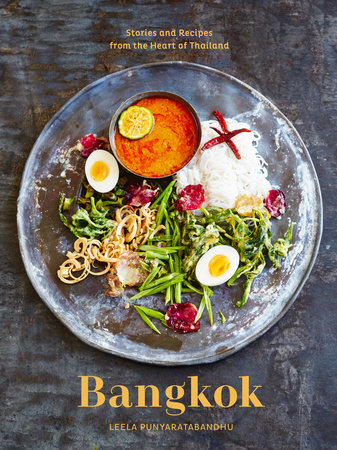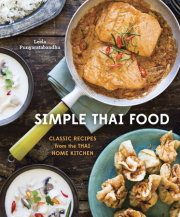THE FOOD OF BANGKOK
As the capital, Bangkok is naturally the first city that comes to mind when people think of Thailand, and as the center of government, Bangkok does represent the entire country. But culturally and culinarily, the city cannot be considered representative of any other place but itself—not even the Central region of which it is part. In other words, Bangkok is unique, and so is its food.
Two key factors have shaped the food of Bangkok, the first of which is geography. Because the Chao Phraya River runs through the city’s heart en route to emptying into the Gulf of Thailand, freshwater fish and river prawns feature prominently in the city’s culinary tradition. Take fish and prawns out of the traditional cuisine of Bangkok and a great chasm would open. Their popularity is due in part to their abundance. But the archaic religious belief that frowns on the killing of larger animals, such as water buffaloes or cows, because they are useful in rice farming and therefore deserve our gratitude and protection, has also contributed to the dominance of aquatic animals. In adherence with that principle, the ancient inhabitants of the alluvial plain of the Chao Phraya subsisted on a simple regimen of rice, fish, fruits, and vegetables. Although by the time Bangkok was founded, pigs, chickens, and ducks had already been incorporated into the diet, and nowadays even though Bangkokians have no qualms about downing a bowl of beef noodles, the remnants of that river-dependent way of life and cooking can still be seen.
History has been an equally important factor in defining the city’s food. Bangkok has always been influenced by foreign cultures through both visitors and settlers, and they have shaped its cuisine at every level, from the royal courts to the grassroots.
The origin of Bangkok traces back to a settlement on the west side of the river that was under the control of the ruling Ayutthaya Kingdom (1357–1767) whose center was located some fifty miles north of contemporary Bangkok. Although small, the village, due to its strategic location on the river, steadily grew in significance as an important customs outpost. That meant that even then Bangkok was exposed to European, Persian, Chinese, and Japanese influences, as well as to groups that had already established their presence in Ayutthaya, such as the Mon, an ethnic group originally from the Mon State in Burma (Myanmar). Ayutthaya was destroyed in 1767, and the Thonburi Kingdom was established the following year. With the change in rulers, the center of government and trade moved to Thonburi, an area on the west bank of the Chao Phraya that is now part of present-day Bangkok. The kingdom ended after a fairly short run, however, and in 1782, Rama I, the first king of the new ruling dynasty, the House of Chakri, established the Rattanakosin Kingdom on the east bank of the river, and with it, the center of power known as Krungthep Maha Nakhon by the Thais and as Bangkok outside of Thailand. The capital—and the economy—grew steadily through burgeoning international trade and thoughtful modernization into a stunning, vibrant, diverse city on both sides of the river.
Today, Bangkok cuisine can be described as an indigenous Central cuisine with heavy influences from a heady blend of foreign cultures—Chinese, Mon, Persian, Portuguese, modern European, North American, and more—resulting in a beautiful, quirky mix that locals and visitors alike can’t get enough of.
Red curry paste NAM PHRIK KAENG PHET This paste is the base for the classic Thai curry that has come to be known internationally as “red curry” due to its reddish color. This so-called Red Curry is, of course, just one among the countless other types of Thai curries, many of which sport the same color. However,
kaeng phet happens to be one of the most common and the most popular type of curry in Bangkok; its paste base is also one of the most versatile which can be used to flavor several non-curry dishes. Makes 1⁄2 cup
4 teaspoons coriander seeds 1 teaspoon cumin seeds 5 large dried Thai long or guajillo chiles, cut into 1-inch pieces, soaked until softened, and squeezed dry 4 dried bird’s eye chiles, soaked until softened and squeezed dry ½ teaspoon white peppercorns 1 tablespoon finely chopped galangal 1 tablespoon thinly sliced lemongrass (with purple rings only) 1 teaspoon finely chopped makrut lime rind 1 teaspoon packed Thai shrimp paste 1 tablespoon finely chopped cilantro roots or stems 5 large cloves garlic ¼ cup sliced shallots Toast the coriander and cumin seeds in a small frying pan over medium-low heat, stirring often, until fragrant, about 2 minutes. Transfer the seeds to a mortar, add the chiles and peppercorns, and grind until smooth. One at time, add to the granite mortar the galangal, lemongrass, lime rind, shrimp paste, cilantro roots, garlic, and shallots, grinding to a smooth paste after each addition. Use immediately, or transfer to an airtight container and freeze for up to 3 months.
Copyright © 2017 by Leela Punyaratabandhu. All rights reserved. No part of this excerpt may be reproduced or reprinted without permission in writing from the publisher.









